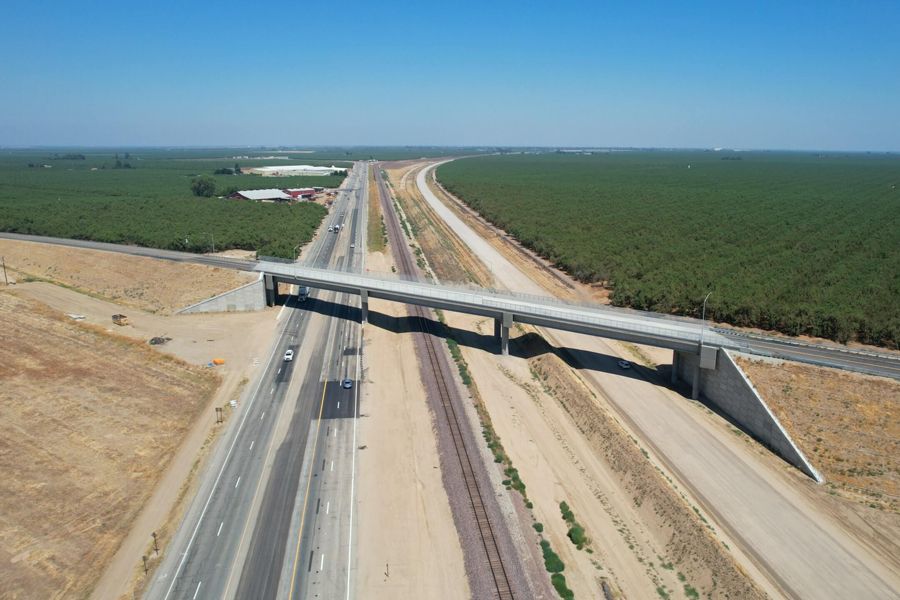Integrating Transit
Integrating advanced transit into California's light-rail rights-of-ways

photo credits: CyberTran,
High Speed Rail Alliance, hsrail.org
Metropolitan Planning Organizations (MPOs) are the government agencies assigned to plan and distribute Federal, State, and local tax dollars to maintain and plan new transportation. The general perception of MPOs is that changes in transportation provoke public discourse. Conversely, when an innovative product is created in the private sector, there is no public discourse. Apple didn’t require a public meeting to implement its i-phone network into the public arena. Nor did Microsoft engage public authorization for its release of Windows. There was no public referendum to introduce the internet, which has literally changed the social course of Western Society.
Tantamount to the heavy impact of large tract-house developments, proposed plans are put to a city council vote regarding zoning. City councils’ zoning approvals place heavy negative traffic impacts to surrounding areas. The effected roads become burdensome impediments to existing road infrastructure, additional traffic loads are unable to accommodate the influx of thousands of extra vehicles.
At present, the public embraces three transportation choices: trains, automobiles, or airplanes. The majority of western civilization land-use growth is automobile centric. Does this indicate that the government transportation agencies are restricted from introducing new methods for transportation?
Transportation improvement
With three modes of transportation available in the developed world, how can a new mode of transportation be implemented? Without having a brand-new mode of transportation available, the only changes to transportation are with incremental adjustments in technology. Automobiles necessitate the crowding of unsustainable sprawl land-use development.
Alternatively, transit-oriented land-use requires fixed rail transit incorporated into vertical high-density development. While high-density transit development builds commerce concentration, it also provides transit user convenience for local residents. Even though most people perceive medium or high-density vertical development as over-crowding, concentrating new urban growth along existing transportation corridors preserves the outlying areas for sparse urban growth and agriculture.
California’s transportation solution opportunity
Step One -
Using California as an example, there are valid ways to improve transportation. The first step is converting the failed CA HSR into a central core for a usable transit system throughout CA. This approach stipulates that local decision-making politicians: comprehend California has hundreds of miles of existing allocated light-rail rights-of-ways. Its infrastructure for usability is already in place.
Second Step -
Secondly are advances in transit system technology which massively exceed the capabilities of expensive retrofitted street cars. Advanced transit technology meets society’s modern transportation demands. The technologies of modern transit systems are unavailable to the older traditional transit. The ultra-light vehicles are smaller. With safe passive-switch ability, new transit technology systems cater to each passenger’s destination. These computer-controlled technology systems remove schedules and are always passenger ready. Modern transit system technology uses a high car count with system capacity at just a few second headway; this delivers passengers to their destinations without unwarranted stops or delays. The advanced technology mitigates traffic congestion with computerized on-demand service. System build-outs can accommodate up to 90% of the metropolitan populations. System designs carry the ability to increase load capacity with population growth.
Politically, advanced transit technology enables urban growth to increase quality of life by establishing medium to high-density urban growth within existing transportation corridors. An essential understanding to urban planning is knowing that transportation is the foundation to all urban growth. Urban planning is dependent upon its transportation network.
As an immediate and comprehensive modern-day transportation alternative, real estate development provides the transportation solution through fixed-rail type transit. With private sector participation, privately funded sustainable-communities development projects can attain environmentally viable urban growth. This type of development can begin immediately with infill real estate developments throughout existing transportation corridors. An important characteristic for this type of development: it attains California’s stringent environmental goals of reducing Vehicle Miles Traveled (VMT).
Economically, as the emergent transit system technology company systems are implemented, they’ll need manufacturing facilities. This brings industrial benefits of economic development and community growth from new engineering and manufacturing jobs. As the VMT is reduced from automobile travel, the necessity of automobile dependency lessens, further reducing economic extraction from the local communities.
Continuation of unsustainability
How much longer will Western Society maintain its dive into the abyss of environmental, economic, and social unsustainability? The phrase: “it’s just the way it is” is technologically unnecessary. Is it not the sworn duty of government officials to serve the public and dedicate their tasks towards improving the public’s quality of life? Whose obligation is it to implement modern transportation advances?
While the public may remain oblivious to the importance of transportation in Western Society, everyone who drives a car is aware of California’s worn-out road infrastructure. Are there any public leaders who are aware of the existing allocated light-rail rights-of-ways with viable plans towards their utilization?
Current environmental, economic, and social problems are directly attributed to the arrangement of unsustainable urban growth; based on automobile centric land-use design. Convenience of the automobile is not offset by the intrusive increase to their numbers. Exacerbating transportation problems are directly related to the unsustainable nature of automobile centric urban growth. The demand for transportation is proportionate to the population. As the population continually grows, needs for mobility excel at a proportionally greater rate. With the growing population, there is an increased demand for land and mobility.
Third step to integrate urban transit within the HSR infrastructure
CA’s financial condition is bleak. The Federal government’s is worse. To financially consider building a brand-new traditional publicly funded transit system infrastructure, is a ludicrous suggestion.
The provision allowing modern transit systems to be implemented into the existing light-rail rights-of-ways is with private sector involvement. The funding mechanism comes from building high-density transit-oriented real estate developments at the transit station sites within existing transportation corridors. These privately built development sites incur the expense of the new transit technology system infrastructure costs. This burden of incurred costs is shared with the government, carrying liabilities as joint venture projects. There are examples where this type of involvement has been tremendously successful.
Conclusion
What do we see in today’s transportation? Every mode of transportation, is from the past. As society has grown technologically, it becomes imperative that transportation technology advance into the 21st Century. Applying prudence; we know that changes to the future, require actions that alter things we do today.
The importance of introducing new technological industries to Central California is key to regional economic security.
It is important socially to implement new mobility options, as well as consolidating the ever-increasing land-use consumption from urban growth.
Post Script note from the author.
These CATTCC articles are the antithesis of sensationalism in marketing. The articles are not hyperbole. This article in particular is authoritatively qualified.
The CATTCC articles are expertly ascertained dissertations arrived through 30 years and $hundreds of thousands spent on didactics of empirical corroboration in urban growth, transportation, and sustainability.



